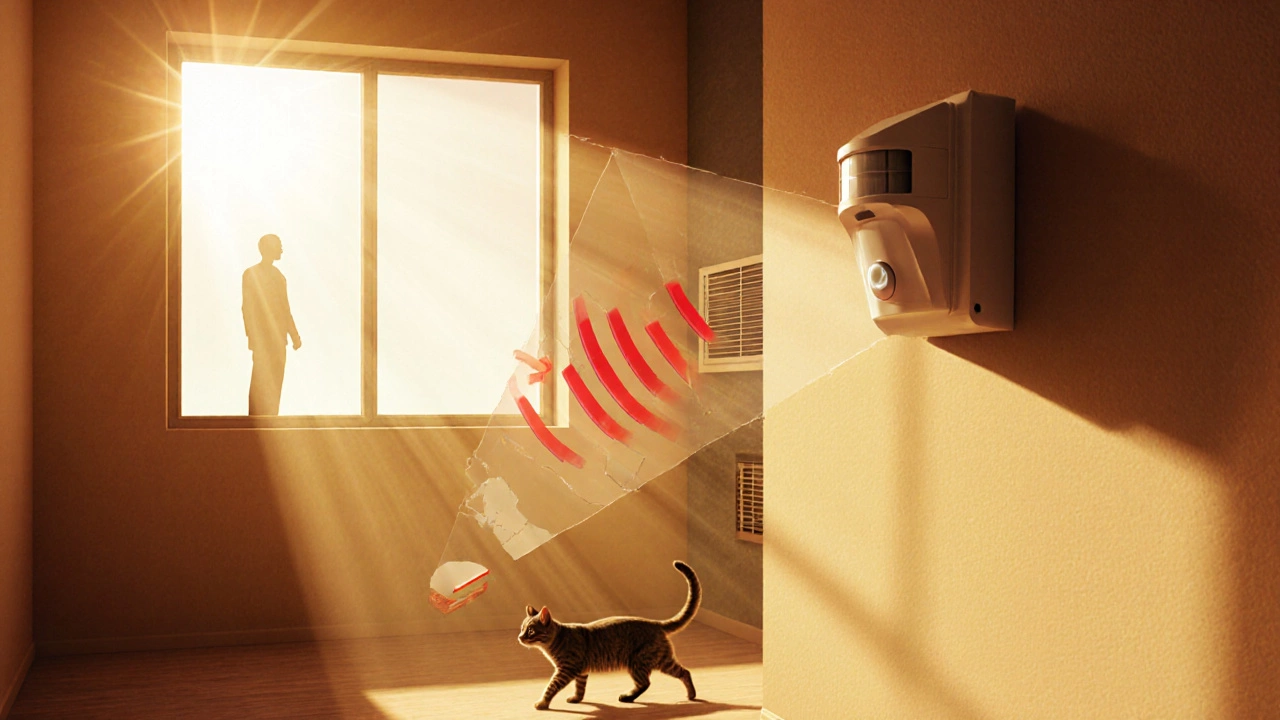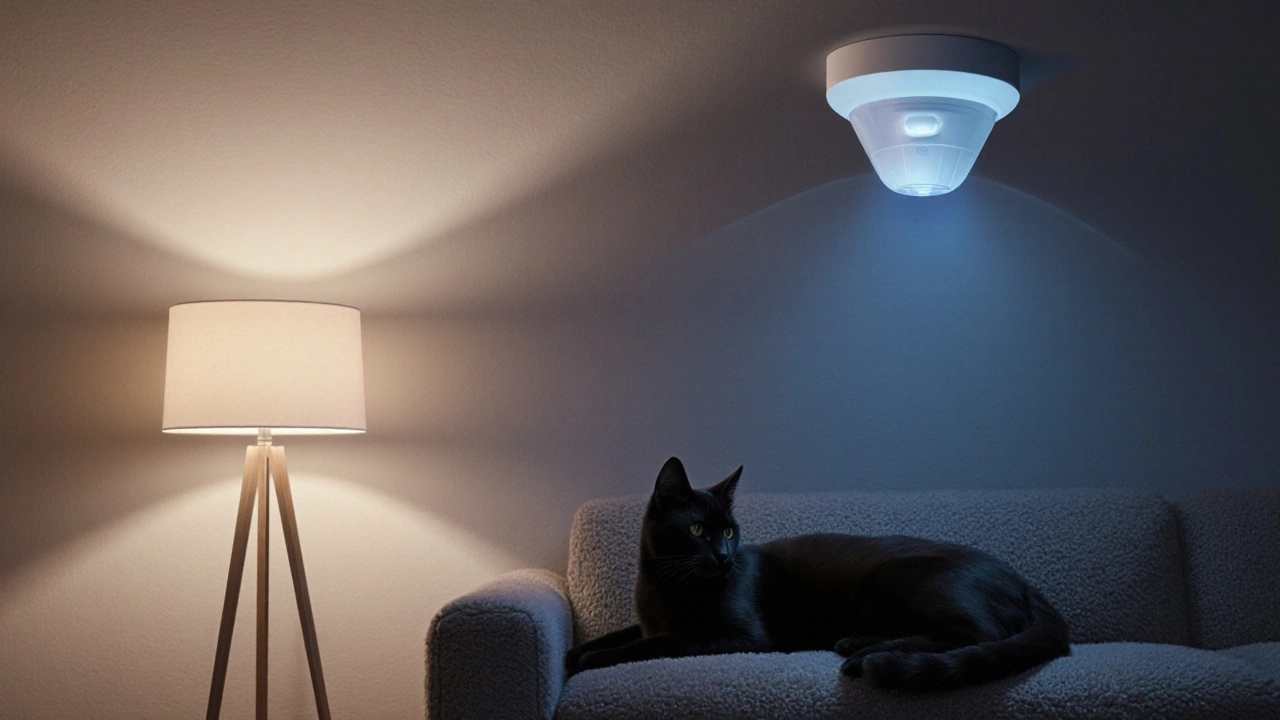When you hear "PIR sensor" in a home‑security brochure, you probably picture a cheap, low‑power motion detector that can spot a burglar and set off the alarm. PIR sensor is a passive infrared sensor that detects changes in infrared radiation emitted by moving objects. It’s the workhorse of most pet‑friendly alarm kits because it can ignore small heat signatures like a cat’s paws. But every technology has trade‑offs, and the downsides of PIR sensors can frustrate homeowners, especially when you expect a flawless system.
Why PIR sensors are a go‑to choice
Before digging into the flaws, it helps to know why they dominate the market. First, PIR sensors are inexpensive-typically $5‑$15 per unit-so a whole‑house setup stays affordable. Second, they operate on minimal power, often just a few milliamps, which lets manufacturers run them off battery for years. Third, the detection principle-measuring infrared radiation-means no radio emissions and no privacy concerns, a plus for pet‑friendly alarms that need to be near cats or dogs.
Core disadvantages you’ll run into
- Temperature sensitivity: PIR sensors rely on a temperature differential between a moving object and its background. On hot summer days or in a sun‑lit room, the ambient temperature can approach a human body’s heat, making the sensor "blind" to motion.
- Limited field of view and blind spots: Most units have a detection angle of 90‑120°, leaving corners uncovered unless you add more sensors. Improper placement can create blind zones where intruders slip by unnoticed.
- Pet immunity trade‑off: To make the system pet‑friendly, manufacturers raise the detection threshold so small animals are ignored. That same threshold can also miss a thin, slow‑moving adult (e.g., a crouching intruder) or delay alarm activation.
- False alarms from environmental factors: Sudden drafts, heating vents, or moving curtains can trigger a rapid temperature change, causing the sensor to fire unexpectedly.
- No range for out‑of‑sight detection: PIR sensors need line‑of‑sight to sense motion; objects hidden behind walls or furniture won’t be detected.
- Latency and "fade‑out": After detecting motion, a PIR sensor stays active for a preset time (usually 30‑120 seconds). If an intruder moves away before the timer ends, the sensor may miss subsequent movement.
How environmental conditions affect performance
Consider a typical living‑room scenario: a large window lets in direct sunlight in the morning, raising the room temperature to 28°C (82°F). A PIR sensor calibrated for a 5°C differential might not recognize a person walking in because their body heat is only a few degrees above the ambient. The same sensor placed near a drafty door could fire every time the HVAC system kicks on, mistaking the airflow for motion.

Comparing PIR sensors with alternatives
| Technology | Detection method | Pet immunity (kg) | Typical range | Cost (USD) | False‑alarm tendency |
|---|---|---|---|---|---|
| PIR sensor | Passive infrared radiation | ≈5‑7kg (small dogs) | 5‑12m | 5‑15 | Medium (temperature changes) |
| Microwave sensor | Active Doppler radar | ≈1‑2kg (hard to ignore pets) | 8‑20m | 12‑30 | Low (ignores temperature) |
| Dual‑technology sensor | Combination of PIR+microwave | Customizable (usually 3‑5kg) | 7‑15m | 15‑35 | Very low (both signals must trigger) |
Notice how dual‑technology sensors dramatically cut false alarms but cost significantly more. If pet‑friendliness is your top priority, a pure PIR sensor still wins on price, but you’ll need to manage its quirks.
Best‑practice tips to mitigate PIR drawbacks
- Map the coverage area: Use the sensor’s spec sheet to draw its detection cone on a floor plan. Add a second unit where angles overlap.
- Adjust sensitivity wisely: Many modern alarms let you fine‑tune the threshold via the app. Find a balance where a 4‑kg cat is ignored but a 70‑kg human triggers reliably.
- Place away from HVAC vents and windows: A few feet from direct drafts reduces temperature‑fluctuation false alarms.
- Consider a dual‑technology upgrade for high‑risk zones: Entry doors and garages benefit from the extra security of combined detection.
- Regularly clean the sensor’s Fresnel lens: Dust and spider webs can distort infrared readings.
- Use motion‑masking features if available: Some controllers let you set virtual “no‑detect” zones to ignore pet‑traffic pathways.
When PIR sensors just won’t cut it
If you live in an area with extreme temperature swings, a pet‑friendly alarm based on PIR alone may generate more headaches than peace of mind. Commercial properties, warehouses, or homes with large glass walls often pair PIR with microwave or ultrasonic sensors to cover blind spots and temperature‑insensitive zones. In those contexts, the PIR sensor disadvantages become decisive factors for choosing a hybrid system.

Future trends that could lessen the pain points
Manufacturers are experimenting with AI‑enhanced signal processing that can differentiate between a pet’s gait and a human’s stride, reducing false alarms without raising the weight threshold. Another promising direction is thermopile arrays that create a low‑resolution heat map, giving the system more context about movement direction while still preserving privacy.
Quick checklist for evaluating PIR‑based pet‑friendly alarms
- Confirm the sensor’s temperature operating range (‑10°C to 50°C is typical).
- Check pet‑immunity specifications-most vendors list a minimum weight.
- Map the detection angle and add overlapping units for corners.
- Verify you can adjust sensitivity via the app or controller.
- Plan placement away from HVAC vents, windows, and reflective surfaces.
- Schedule annual lens cleaning and firmware updates.
Frequently Asked Questions
Can a PIR sensor detect a crawling intruder?
Yes, but detection depends on how much of the body’s heat is exposed. Crawling reduces the effective infrared area, so the sensor may need a lower threshold or a supplementary motion detector.
Why does my alarm go off when the thermostat kicks on?
The sudden airflow changes the temperature near the sensor, creating a rapid infrared shift that the PIR interprets as motion. Relocating the sensor away from vents usually solves the issue.
What pet weight can a typical PIR sensor ignore?
Most pet‑friendly models ignore animals under 5‑7kg (about 11‑15lb). Check the manufacturer’s spec sheet; some allow you to set the threshold manually.
Is it worth replacing PIR with a dual‑technology sensor?
If false alarms are frequent or you have high‑traffic pet zones, dual‑technology offers a solid trade‑off: higher cost but dramatically fewer false alerts and better coverage of temperature extremes.
How often should I clean the PIR sensor lens?
A quick wipe with a dry microfiber cloth every six months prevents dust buildup, which can blur infrared detection and increase false alarms.

